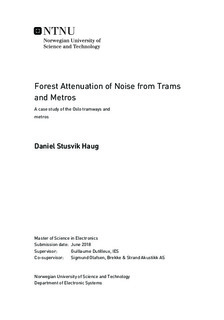Forest Attenuation of Noise from Trams and Metros - A case study of the Oslo tramways and metros
Master thesis
Permanent lenke
http://hdl.handle.net/11250/2564176Utgivelsesdato
2018Metadata
Vis full innførselSamlinger
Sammendrag
The influence of vegetation and trees on sound propagation has been investigated by compar-ing measurements of metro and tram noise pass-by in an open field with a forest. The mea-surements are based on the metros and trams that run in Oslo, and the test site is located atJarmyra in Bærum close to Oslo. All the measurements are done during the winter and earlyspring which means that the ground mostly is snow-covered and that the measurements areperformed without vegetation in form of leaves. The forest consists of a mixture of spruce and birch with an average stem diameter in the range from 0.5 to 40 cm and an average height of 3 to 15 m. The average density of the forest ranges from 0.7 to 1.4 stems per square meter.
Inbound and outbound traffic which run on two separate tracks with a separation distanceof four meters has been measured by the use of three microphone positions 1.3 m above therail head placed normal to the tracks. The separation distance between the microphones is 10m, and the microphone closest to the tracks is placed at a distance of six meters. This gives six different measurements distances at 6, 10, 16, 20, 26 and 30 m from the closest tracks. All the measurements are performed in the near field of the noise source.
When the frequency spectrum based on the parameter maximum sound pressure level withtime weighting fast is compared between the microphone positions located 6 and 26 m fromthe center line of the outbound traffic track, there is an excess forest attenuation of 0.6 and 1.6 dB for the tram and metro measurements, respectively. This result yields for the entire audible frequency range spanning from 20 Hz to 20 kHz.
The results suggest that the frequency range below 1 kHz is mostly affected by interferenceeffects and that the attenuation between open field and forest measurements start to differ from 1-2 kHz. By the consideration of the frequency range 1 to 20 kHz and sound propagation through 20 m of forest, the excess forest attenuation is 0.5 and 2.3 dB for trams and metros, respectively. With a 90 % confidence interval taken into account, the tram measurements have an excess forest attenuation between 0.1 to 0.9 dB whereas the metro measurements have an excess forest attenuation between 2.1 and 2.5 dB.
As these measurements are based on a sound propagation through 20 m of forest, the excessforest attenuation in the frequency range from 1 to 20 kHz can be approximated as 0.12 dB/mfor metro noise. The excess forest attenuation for tram noise is negligible for this range.
